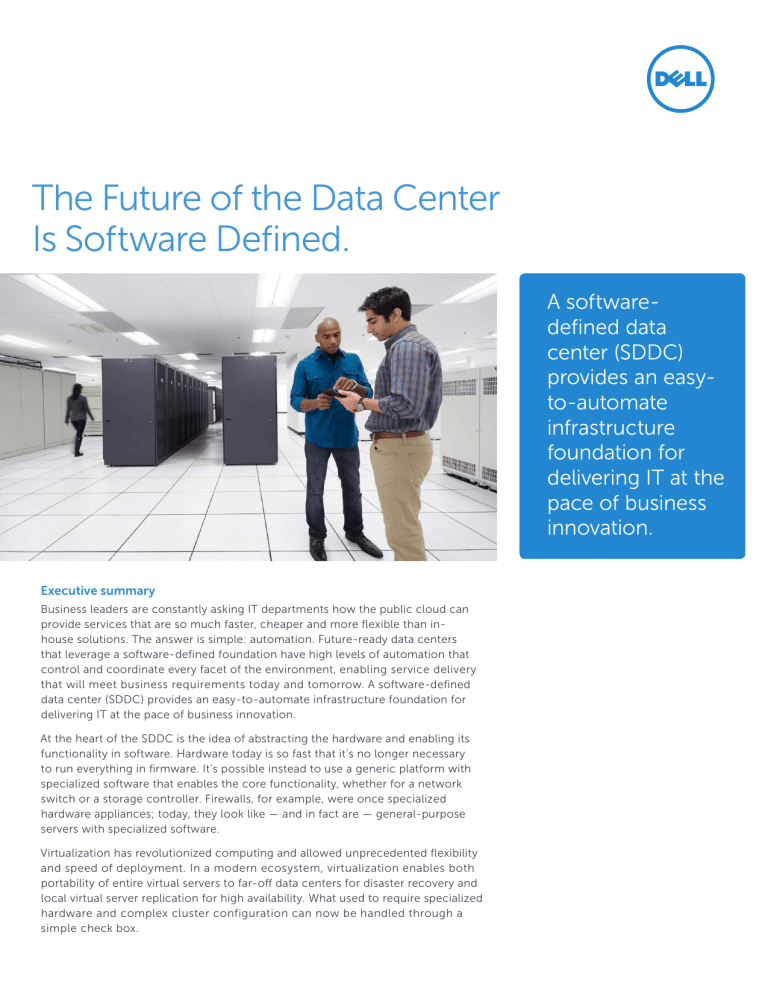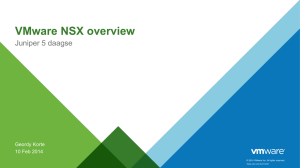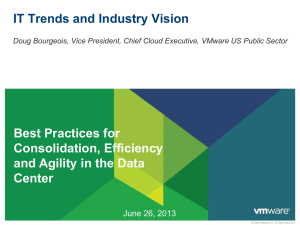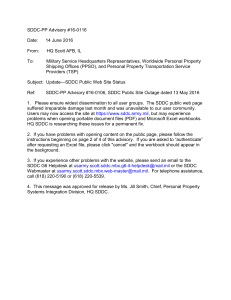
The Future of the Data Center
Is Software Defined.
A softwaredefined data
center (SDDC)
provides an easyto-automate
infrastructure
foundation for
delivering IT at the
pace of business
innovation.
Executive summary
Business leaders are constantly asking IT departments how the public cloud can
provide services that are so much faster, cheaper and more flexible than inhouse solutions. The answer is simple: automation. Future-ready data centers
that leverage a software-defined foundation have high levels of automation that
control and coordinate every facet of the environment, enabling service delivery
that will meet business requirements today and tomorrow. A software-defined
data center (SDDC) provides an easy-to-automate infrastructure foundation for
delivering IT at the pace of business innovation.
At the heart of the SDDC is the idea of abstracting the hardware and enabling its
functionality in software. Hardware today is so fast that it’s no longer necessary
to run everything in firmware. It’s possible instead to use a generic platform with
specialized software that enables the core functionality, whether for a network
switch or a storage controller. Firewalls, for example, were once specialized
hardware appliances; today, they look like — and in fact are — general-purpose
servers with specialized software.
Virtualization has revolutionized computing and allowed unprecedented flexibility
and speed of deployment. In a modern ecosystem, virtualization enables both
portability of entire virtual servers to far-off data centers for disaster recovery and
local virtual server replication for high availability. What used to require specialized
hardware and complex cluster configuration can now be handled through a
simple check box.
By applying the principles behind virtualization of compute to
other areas such as storage, networking, firewalls and security,
we reap its benefits throughout the data center. And it’s not
just virtual servers: entire network configurations can be
transported to distant public or private data centers to provide
full architecture replication. Storage can be provisioned
automatically in seconds and perfectly matched to the
application that needs it. Firewalls are now part of the
individual workload architecture, not of the entire data center,
and this granularity against threats inside and out, yielding
unprecedented security.
But what does it all mean? Is the SDDC some high-tech fad
or invention? Absolutely not. The SDDC is the inevitable result
of the evolution of the data center over the last decade.
The evolution of the data center
This evolution has happened quickly, and it is worth discussing
how it unfolded. Virtualization was born in the mainframe,
and its application to the x86 server proved vital. Critical IT
services were no longer tied to individual physical servers,
and applications gained dramatic improvements in density,
scalability and portability. Today, the growth of big data
and analytics and the emergence of the Internet of Things
(IoT) have created more storage, networking and security
complexity. This complexity is expensive, not only because
of the capital expense of hardware, the ongoing operational
expense of managing it and the lack of visibility and reporting,
but also because of the lack of agility and flexibility of
traditional data centers.
To administer the increasingly complex infrastructure,
functional management silos of compute, storage and
networking have evolved over time, each silo requiring
specialized management skills. Additionally, the individual silos
have grown independently to address their specific concerns,
often without a broader perspective of the entire environment.
This is problematic for today’s businesses because it makes it
difficult to manage change, address incidents or innovate.
Ironically, the very data center architectures that powered
business improvement and innovation have now become
an impediment to continued growth.
Thankfully, virtualization can once again address the increasing
demands on IT infrastructure. Extending the concept of
virtualization to the entire data center makes it possible to
abstract, pool and automate all areas of the data center and
achieve IT as a Service.
A history of the data center
1940s
Early mainframe
computers emerge.
1970s
ARCNET and AR PANET
are early precursors of
the Internet .
1984
Dell Inc. is founded in
a dorm room at the
University of Texas.
1990s
Client-server
computing begins.
computing moves to
the data center.
1998
VMware is founded in
Palo Alto, California,
bringing virtualization
to the x86 world.
Mid 2000s
x86 server
virtualization arrives
to help improve
utilization of the
Internet-era data
center.
Late 2000s
Modular data centers
appear and advanced
virtualization opens
the door for “the
cloud.”
Tomorrow
We lcome to the world
of software-de ned
everything.
2
1960s
Mainframes go
mainstream. Compute
functions are
partitioned (virtualized)
to improve utilization.
1980s
The personal
computer arrives.
Early virtualization
technologies are
abandoned as
multitasking moves
out of the data center.
Late 1990s
The emergence of the
Internet creates an
explosion in demand
for data centers with
advanced capabilities.
Early 2000s
Internet demands
catch up with the
data center, creating
massive power and
Late 2000s
Software as a Service
(SaaS) and cloud arrive
— and multi-tasking
functions begin to
move back into the
data center.
Early 2010s
Virtualization extends
to storage and
networking.
Today
Cloud technologies
are increasingly
automated and hybrid
in nature.
The SDDC: a service-first strategy
IT has become a strategic asset and in order to stay competitive, modern
businesses must include technology-based services, and do so quickly.
But achieving speed and efficiency in a siloed data center can be a
real challenge.
“Extending the
concept of
virtualization to
the entire data
center makes
it possible to
abstract, pool and
automate all areas
of the data center
and achieve IT as
a Service.”
“Management is moving closer to compute, and what started with
virtualization (software-defined compute) has expanded to include
software-defined storage and software-defined networking. What’s more,
convergence is breaking down management barriers, changing the way data
centers are deployed and simplifying management functions. All of these
core technologies combine to create the software-defined data center. ”
— Luke Mahon
Dell Enterprise Solutions Group
The building blocks of the SDDC are straightforward. The primary goal is
to be able to manipulate each of these components in a standardized way
through software. Orchestration, automation and policy enablement can
be accomplished via management software to enable a more efficient and
integrated architecture.
Compute virtualization: Also referred to as server virtualization, compute
virtualization is an essential building block for the SDDC. Pioneered by VMware
in the x86 server space, it allows multiple physical servers to be shared (via a
hypervisor) by multiple encapsulated virtual machines. The workload or service
(i. e., the specific application or business functionality) thus becomes decoupled
from the underlying hardware.
Software-defined storage (SDS): In a data-intensive world, SDS helps ensure
that the pools of storage needed for various applications and services remain
available and accessible. Storage virtualization can be very powerful by coupling
the data to the workload. It can do this because it knows about the workload,
not just the storage pool, as in traditional implementations. As the scale and
type of data change, zettabyte-scale data lakes become prohibitively expensive
and the business needs solutions that will scale with the data requirements.
SDS can help build massive scale with commodity hardware at a fraction of
the cost of traditional enterprise storage.
IT silos
Software
Networking
Storage
Server
The software-defined data center
building blocks
App
App
App
Orchestration stack
Infrastructure control
Server
Storage
Networking
Open standards-based hardware
3
Software-defined networking (SDN): SDN evolved because the old practice
of manually connecting has become unsustainable in today’s complex data
center. SDN only requires the physical connection of cables to happen once,
after which software can be used to manage, control and alter the flow of
information as needs change. This allows for architectures in which workloads
live on their own network, completely isolated and firewalled from the rest of
the data center, and in which networks can be created for application testing
and then instantly decommissioned after the testing. This is possible because
the network is tightly coupled to the workload or application.
Management: The SDDC depends on software to manage all of the
infrastructure resources in the data center. In a traditional data center,
each silo is managed within its own domain. The SDDC management software
bridges the silos so that all of the necessary resources can be viewed and
managed together. Properly implemented, the SDDC will dramatically
reduce the number of tools and resources needed to build and manage the
infrastructure.
Security: The management software extends beyond the data center
components of server, network and storage to the application layer. This is
how the SDDC approach couples the infrastructure resources to the unique
needs of a particular application, service or workload. When security principles
are applied to the entire ecosystem of an application, security can be based
on specific requirements. For example, the network topology is not based
on or limited to a coarse construct such as a VLAN or a network location but
instead on the application’s unique connectivity requirements. As a result,
individual workloads can run in their own microsegmented space with each
microsegment having its own unique policy-based security.
Choosing the right approach to the SDDC
In determining how to approach SDDC implementation, keep in mind that the
SDDC is an infrastructure-architecture approach, not necessarily a destination.
Therefore, you don’t have to “software-define” your entire infrastructure all at
once. Keep in mind, too, that the SDDC is an extension of technologies that
your business has probably already adopted, so you don’t have to start over.
IT evolution
4
Future-ready
IT design tenets
The SDDC approach allows IT to
focus on a core set of outcomes
that delivers significant business
benefits. These outcomes include:
Accelerating innovation
•A
pplication and infrastructure
automation with services
delivered in minutes rather than
days or weeks
•S
treamlined and automated data
center operations
• Increased choice, flexibility and
extensibility
Improving security and control
•M
icro-segmentation of workloads
to prevent the spread of threats by
encapsulating workloads (which
are comprised of networks, virtual
machines and applications) with
security policies like firewalls to
provide fine-grained security
control
•A
utomating availability and
recovery to enable policy-based
application and service continuity
across the IT infrastructure (both
on-site and in the cloud) to ensure
that workloads are available and
backed up at all times
SDDC offers numerous benefits,
but think through your
implementation:
•T
he SDDC approach, like server
virtualization, can result in added
complexity. Don’t rush in without
a roadmap.
You can, and should, take advantage of existing investments. What we’re really
talking about is a fundamental shift in philosophy. The SDDC reflects a change
in how you manage resources, not a change in the resources themselves, and
in how you align IT services to business needs. Most Dell customers have
already taken the first step with compute virtualization and many are adopting
SDN and SDS.
At Dell, we see three approaches to SDDC adoption:
1. Bimodal: The first approach is to adopt Gartner’s Bimodal IT concept and
run traditional IT alongside an SDDC infrastructure. As you acquire new
hardware to support a specific workload, you can take an SDDC approach to
ease into this new world. Many vendors have reference architectures as well as
fully engineered, prepackaged and validated solutions that can save countless
hours of hardware assembly and configuration. Adopting such a “cloud in a
box” architecture is an expeditious way to enable a bimodal approach.
2. Fully software defined: The second and somewhat bolder approach is to
implement a fully software-defined environment. This typically only happens
during a major restructuring event such as a divestiture or a greenfield cloud
implementation. Such deployments offer the most latitude for implementing
a fully software-defined environment since they are not constrained by legacy
considerations. However, with no existing fabric, they also require significant
planning to ensure that every aspect of a modern data center is taken into
account. One exciting attribute of a brand-new data center could be modern
facility management software that provides APIs that communicate with the
SDDC management software, so that workload placement is informed by
the physical attributes of the data center. This enables the workloads to be
informed of not only the base compute, network and storage, but also the
physical environment in which it will be launched.
3. Evolutionary: The third and final approach is evolutionary. As systems reach
end of life, you replace them with modern systems capable of supporting
an SDDC architecture, and you upgrade network or storage functionality
in keeping with the SDDC vision for the data center. Converged appliances
replace distributed systems to allow rapid compute deployments and upgrades.
And as the hardware evolves, you migrate its management to the SDDC
management platform.
During the early days of compute virtualization, deployments showed the value
of the technology and gave the organization the experience and skills
needed to support the virtual infrastructure as it grew. This remains true with
the deployment of SDDC.
5
•B
eware of vendors who are trying
to sell a monolithic product rather
than a holistic integrated solution
based on standardized APIs.
Some vendors will try to sell you
a proprietary approach to SDDC,
which can result in trading one set
of silos for another.
•A
utomation makes everything
easier — including breaking things.
Make sure you test and look for
problems before you roll out your
solutions.
•S
DDC is a fundamental shift that
requires both business and IT to
be on board and in sync. Some
groups, especially IT, will have
to rethink their processes and
organization. Be aware of political
pressure or turf wars within your
own organization.
The SDDC paves the way for your journey
to hybrid cloud
Dell believes the future of the data center is going to
be hybrid — spanning hardware that you own and
cloud-based infrastructure that you use on demand
from others. Public-cloud providers are already fully
software defined, and mirroring that architecture in
your data center will make hybrid integration much
simpler. However, this path to hybrid cloud delivery is
not without turns and bumps. You certainly don’t want
to head out in the wrong direction or to have your
route dictated by a single vendor’s vision of SDDC.
The ultimate goal is to have your internal SDDC
infrastructure closely mirror the public cloud, with
your workloads modernized and architected to take
full advantage of this approach. Your infrastructure will
then be ready to deliver IT as a Service with the same
agility and flexibility that your workforce has come to
expect. This allows for a seamless transition between
the on-premise and public cloud to enable your
hybrid cloud, something that would be difficult with
a traditional environment.
Dell solutions are designed from the beginning to
be future-ready. They’re based on open standards,
with the modularity and scalability to give your
organization the agility it needs to capitalize on every
opportunity — even the ones that don’t exist yet. Our
end-to-end solutions provide the ideal foundation for
the SDDC approach, whether you’re just starting out
or adding to what you’ve already built.
If you aren’t sure where to begin, our consultants
can help you assess your current environment,
then design and implement a plan for an efficient,
future-ready data center. Dell offers consulting
workshops to help identify the best place to start
on your journey. Find out more by visiting
www.dell.com/itconsulting.
Ten steps to success:
Planning your software-defined data center
Make a plan:
1.
Identify business priorities and needs over the next
three to five years and align IT to those initiatives.
2. E nsure your SDDC foundation supports your
corporate cloud strategy.
3.
Document legacy manual processes, especially
4.
Understand the limitations of existing technology,
5.
Ensure any new investments can integrate into the
6.
those that slow down service delivery.
such as the absence of automation or a lack of
open APIs.
existing environment to avoid extensive custom
integration.
Document requirements and ensure any new
technology investments will be fully leveraged. Don’t
just go for the new shiny features without assessing
their value to your implementation.
7. R ecognize that a new culture and supporting
organizational structure will be necessary.
8.
9.
10.
Develop metrics that show business value to enable
investment.
U
nderstand which services are better suited to an
external provider.
ick a pilot area and start small to demonstrate
P
quick wins.
Look for partners and vendors with:
A long-term partnership that drives the SDDC
• A deep history of partnership and joint development
There are many choices to make in your SDDC
journey. One of the most significant decisions you
face is in your choice of technology partners. Dell
and VMware are ideally suited to help you achieve
your SDDC goals and vision. The two companies
have a long history of joint development of tightly
integrated solutions. Dell is the largest reseller
of VMware in the world and was recognized as
VMware’s Global Strategic Alliance Partner of the
Year in 2016.
• A
comprehensive approach and vision for the future
of the SDDC
• A commitment to standards-based technologies
• A strong track record and deep experience in delivering
virtualized solutions
Dell and the Dell logo are trademarks of Dell Inc. Other trademarks and trade names may be used in this document to refer to either the
entities claiming the marks and names or their products. Dell disclaims proprietary interest in the marks and names of others. © 2016 Dell Inc.
All rights reserved. March 2016 | The Future of the Data Center is Software Defined



